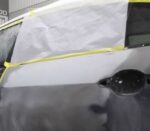Let’s face it…production painting is hard work. Why make it harder?
Getting cars done is all about the order and number of operations
 My name is Tim Briggs. I have been standing and watching paint shops across North America run for years. I’ve come to realize that getting cars done is all about the order and number of operations we perform. Cars don’t care how many times we touch them or how much time it takes to get them done.
My name is Tim Briggs. I have been standing and watching paint shops across North America run for years. I’ve come to realize that getting cars done is all about the order and number of operations we perform. Cars don’t care how many times we touch them or how much time it takes to get them done.
Take the priming process for example. Let’s assume we are priming a quarter panel with plastic filler just out of the body shop. How many times will we prep that car? You may have said “1”. I hope that is the case. Here is the reality. Many times we fail to plan the whole process because we are focused on the part of the job at hand.
So here is how it goes, We…
- check the filler for pinholes (a whole separate topic in itself).
- feather back the scratches around the filler. (Hopefully minor if the plastic process is right.)
- sand back to where we estimate the primer will end.
- soft line mask the primer area.
- clean and prime the car.
- After dry time we unmask the car, block the primer, decide if we need to re-prime (production killer)
- sand or scuff the rest of the quarter, sail, roof, etc.
- mask the car.
- catch any prep issues in the booth
- Finally… WE PAINT
Sound pretty typical? Ok so here is the point. In this example alone, we turned one process into three. Why do we sand for primer, sand for prep and sand to touch up in the booth? It’s the same operation but it starts and stops THREE TIMES!
New Process:
- Check the filler
- Prep the entire job booth ready pay attention to detail
- Refine your scratches around the filler
- Do minimal masking, use short plastic instead of building tents out of 36″ green. Be smart with the way you prime, HVLP or even roll prime if the repair is small
- Block the primer and wrap up the car once the job is cured
- Paint
Problems this solves:
1. If you have to go larger than you thought with the primer, there is no tear back from the unprepared surface.
2. The sanding operation is done 1 time. (Hopefully from a prep cart so materials are handy and not wasted by throwing stuff on the floor between steps) less sandpaper used is important since 8-10% of a shop’s purchases are abrasives.
3. The bulk of the prep work is completed before the cure time wait. This gets the car in the booth faster once it’s dry.
4. Sanding the bulk of the job early reduces the sanding dust later in the process for cleaner paint jobs.
5. The biggest win…higher booth utilization. More cars, same effort, different order of (streamlined) operations.
Please feel free to comment and share as we all learn together.
TB
